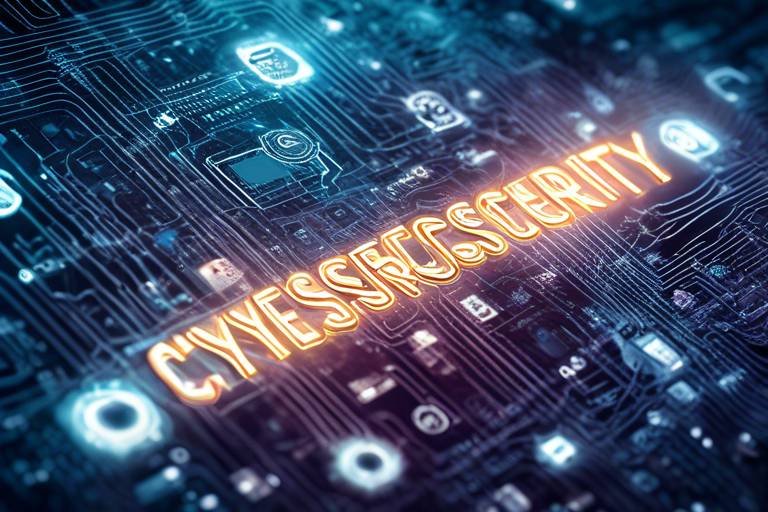How to Handle a Ransomware Attack
In today's digital age, the threat of a ransomware attack looms larger than ever. Imagine waking up one morning to find that all your important files are locked away, and a sinister message demands payment for their release. It's a nightmare scenario that can happen to anyone, whether you're an individual, a small business, or a large corporation. Handling a ransomware attack effectively requires a combination of prevention strategies, immediate response actions, and recovery measures. This article aims to equip you with essential guidance on managing ransomware attacks, so you can safeguard your data and systems effectively, and hopefully, never find yourself in that harrowing situation.
First, let's dive into what ransomware actually is. Ransomware is a type of malicious software designed to encrypt your files, making them inaccessible until a ransom is paid. Understanding how ransomware operates is crucial for both prevention and response. It often spreads through phishing emails, malicious downloads, or vulnerabilities in software. Once it infiltrates your system, it encrypts files and displays a ransom note, usually demanding payment in cryptocurrency. This is why being informed and prepared is your best defense against these cybercriminals.
Taking proactive steps can significantly reduce the risk of a ransomware attack. Prevention is always better than cure, right? By enhancing your cybersecurity posture, you can shield yourself from potential threats. Key strategies include maintaining regular backups, utilizing robust security software, and educating yourself and your team about safe online practices. The more layers of security you have, the harder it becomes for attackers to breach your defenses.
One of the most effective ways to mitigate the impact of a ransomware attack is to maintain up-to-date backups. Think of it as having a safety net for your data. If your files become encrypted, having a backup means you can restore everything without paying the ransom. Best practices for implementing and managing backups include:
- Backing up your data regularly, ideally daily or weekly, depending on how often your data changes.
- Storing backups in multiple locations, such as an external hard drive and a cloud service, to ensure redundancy.
- Testing your backups regularly to ensure that your data can be restored quickly and accurately when needed.
Determining how often to back up your data can significantly affect your recovery speed after an attack. If you back up daily, you might only lose a day's worth of work. However, if you only back up weekly, you could lose an entire week of data. It's essential to find a balance that works for your specific needs and the nature of your data.
Choosing the right storage solutions for your backups is critical. Here are some options:
| Storage Solution | Pros | Cons |
|---|---|---|
| External Hard Drives | High capacity, easy to use | Physical damage risk, theft |
| Cloud Storage | Accessible from anywhere, scalable | Subscription fees, potential security risks |
| Network Attached Storage (NAS) | Centralized storage, good for teams | Requires technical knowledge, initial setup cost |
Utilizing robust security software is vital for detecting and preventing ransomware. Look for software that offers real-time protection, regular updates, and features like email filtering and web protection. The right security tools can act as a barrier, blocking ransomware before it even has a chance to infiltrate your system.
In the unfortunate event of a ransomware attack, knowing how to respond can minimize the damage. First and foremost, remain calm. Panic can lead to hasty decisions that may worsen the situation. Instead, follow a structured response plan to help you navigate through the chaos.
Quickly isolating infected systems is crucial to prevent further spread. Disconnect the affected devices from the network and disable Wi-Fi connections. This action can help contain the attack and protect other devices from being compromised.
Understanding the extent of the attack is essential for formulating a recovery plan. Take inventory of what has been affected—files, applications, and systems. Knowing what you’re dealing with will help you decide on the best course of action moving forward.
Recovering from a ransomware attack involves restoring your data and systems. This process can be complex, but with the right strategies, it’s manageable. Start by implementing effective data restoration techniques, such as restoring from backups or using recovery tools.
Implementing effective data restoration techniques is essential for recovery. Depending on your backup strategy, you may have multiple options for restoring data. Ensure you follow best practices to avoid further complications during the restoration process.
Finally, conducting a post-attack review can reveal vulnerabilities in your systems. Analyzing the incident helps strengthen your defenses against future ransomware threats. What went wrong? Where were the gaps in your security? Addressing these questions can lead to a more robust cybersecurity posture.
- What should I do if I receive a ransom note? Do not pay the ransom. Instead, isolate the infected systems and seek professional help.
- Can I prevent ransomware attacks entirely? While you can't guarantee complete prevention, implementing strong cybersecurity measures can significantly reduce your risk.
- How often should I back up my data? Ideally, back up your data daily or weekly, depending on how frequently it changes.

Understanding Ransomware
Ransomware is not just a buzzword; it’s a **growing threat** that can leave individuals and organizations in a state of panic and chaos. Imagine waking up one morning to find that all your important files are locked away, and the only way to get them back is to pay a hefty ransom. This is the reality for many victims of ransomware attacks. At its core, ransomware is a type of malicious software, or malware, that encrypts files on a victim's system, rendering them inaccessible until a ransom is paid to the attackers. Understanding how ransomware works is crucial for both prevention and effective response.
Typically, ransomware infiltrates a system through various means, such as phishing emails, malicious downloads, or exploiting vulnerabilities in software. Once inside, it begins encrypting files, often targeting sensitive data like documents, photos, and databases. The attackers then display a ransom note, demanding payment—usually in cryptocurrency—to unlock the files. This **demand** can range from a few hundred to thousands of dollars, and the attackers often use threats to instill fear, claiming that failure to pay will result in permanent data loss.
What makes ransomware particularly insidious is its ability to spread rapidly across networks. For instance, if one computer in an office becomes infected, it can quickly propagate to others, causing widespread disruption. This is why understanding the mechanics of ransomware is not just about knowing what it is; it’s about being able to identify potential vulnerabilities in your system before an attack occurs.
To give you a clearer picture, let’s break down the key components of ransomware:
- Infection Methods: Common ways ransomware spreads include phishing emails, malicious links, and software vulnerabilities.
- Encryption: Once inside, the malware encrypts files using strong algorithms, making them unreadable without a decryption key.
- Ransom Note: After encryption, victims receive a ransom note detailing how to pay for the decryption key.
- Payment Options: Payments are typically demanded in cryptocurrencies like Bitcoin, making it hard to trace.
Understanding these components not only helps in recognizing the threat but also in developing effective strategies to defend against it. The more informed you are about how ransomware operates, the better equipped you will be to protect your data and systems. Remember, prevention is always better than cure, and being proactive can save you from the nightmare of a ransomware attack.

Preventive Measures
When it comes to ransomware, an ounce of prevention is worth a pound of cure. Just like you wouldn’t leave your front door wide open in a bad neighborhood, you shouldn’t leave your digital assets unprotected. Taking proactive steps can significantly reduce the risk of falling victim to a ransomware attack. Here are some essential strategies to enhance your cybersecurity posture:
First and foremost, regular backups are your safety net. Imagine having a safety deposit box filled with important documents; similarly, maintaining up-to-date backups ensures that even if your primary data is compromised, you have a secure fallback. But it’s not just about backing up your data; it’s about doing it right. You need to establish a backup routine that fits your needs, whether that’s daily, weekly, or even hourly depending on how critical your data is.
Determining how often to back up your data can directly affect how quickly you can recover. For instance, if you only back up once a week and an attack occurs just after your last backup, you could lose an entire week’s worth of work. A good rule of thumb is to assess how often your data changes and back it up accordingly. Here’s a quick breakdown:
| Data Change Frequency | Recommended Backup Frequency |
|---|---|
| Every hour | Hourly backups |
| Daily | Daily backups |
| Weekly | Weekly backups |
Choosing the right storage solutions for your backups is critical. It’s like choosing between a piggy bank and a vault to store your valuables. Here are some options to consider:
- External Hard Drives: Great for quick access but can be physically stolen or damaged.
- Cloud Storage: Offers remote access and is less prone to physical damage, but you must trust the service provider.
- Network Attached Storage (NAS): Provides centralized storage over a network, allowing multiple users to access it but requires proper configuration and security measures.
Each option has its pros and cons, so weigh them carefully based on your specific needs and potential threats.
Utilizing robust security software is vital for detecting and preventing ransomware. Think of it as your digital bodyguard, keeping watch over your sensitive information. Look for software with features such as real-time scanning, automatic updates, and ransomware-specific protection. Some recommended solutions include:
- Antivirus software with ransomware protection
- Firewalls to block unauthorized access
- Intrusion detection systems to monitor unusual activity
Investing in the right security software is like putting on armor before heading into battle; it significantly increases your chances of coming out unscathed.
In conclusion, while no system can be completely foolproof, implementing these preventive measures can dramatically reduce your risk of a ransomware attack. Just as you wouldn’t drive without a seatbelt, don’t navigate the digital world without these essential protections in place.

Regular Backups
When it comes to defending against the menacing threat of ransomware, stand as one of your most formidable allies. Imagine your data as a precious treasure chest; without a reliable backup strategy, you're risking everything every time you connect to the internet. Ransomware can strike at any moment, encrypting your files and demanding a ransom for their release. However, if you've maintained up-to-date backups, you can simply restore your data and avoid paying those criminals. But what does it mean to have effective backups in place? Let's dive into the best practices that can help you secure your data.
First and foremost, it’s essential to understand that not all backups are created equal. You need to consider factors such as backup frequency, storage solutions, and backup verification. A backup that hasn’t been updated in months is almost as good as having no backup at all! Therefore, establishing a robust backup routine is crucial. Generally, the more frequently you back up your data, the less you risk losing in the event of an attack. For many organizations, a daily backup schedule is a good starting point, but for critical data, consider real-time backups if resources allow.
Next, let's talk about where to store these backups. You have several options, and each comes with its own set of pros and cons. Here’s a quick overview:
| Backup Storage Solution | Pros | Cons |
|---|---|---|
| External Hard Drives | Cost-effective, easy to use | Vulnerable to physical damage, theft |
| Cloud Storage | Accessible from anywhere, scalable | Ongoing costs, dependent on internet |
| Network Attached Storage (NAS) | Centralized access, automated backups | Higher initial cost, requires setup |
Each option has its merits, and the best choice often depends on your specific needs and resources. Additionally, it’s wise to implement a 3-2-1 backup strategy: keep three copies of your data, store two of them on different devices, and keep one copy offsite. This way, even if one storage solution fails or gets compromised, you still have other copies to fall back on.
Lastly, don’t forget about backup verification. Just because you have backups doesn’t mean they’re usable. Regularly test your backups to ensure that you can restore your data quickly and effectively. Imagine trying to retrieve your treasure only to find that the key has been lost or the chest is empty! By routinely verifying your backups, you can rest easy knowing your data is safe and sound.
In summary, regular backups are not just a recommendation; they are a necessity in today’s digital landscape. By following these best practices, you can significantly reduce the impact of a ransomware attack and ensure that your data remains intact. Remember, it’s not about if you’ll face a ransomware attack, but when. So, prepare today to safeguard your data for tomorrow!

Backup Frequency
When it comes to establishing a backup frequency, the question isn't just about how often you should back up your data; it's about finding a balance that works for your specific needs. Imagine your data as a river that flows continuously. If you only take a snapshot of it once a week, you might miss out on valuable information that gets washed away every day. Therefore, the frequency of your backups should be dictated by the rate at which your data changes. For example, if you’re running an e-commerce site that updates inventory and sales in real-time, daily or even hourly backups might be necessary. On the other hand, if you're a small business with less frequent changes, weekly backups could suffice.
To help you determine the right backup frequency, consider the following factors:
- Data Sensitivity: How critical is the data? The more sensitive the data, the more frequently you should back it up.
- Business Operations: Consider how often your business operations generate new data. More dynamic environments require more frequent backups.
- Regulatory Compliance: Some industries have specific regulations regarding data retention and backup frequency. Make sure to comply with those requirements.
In addition, you might want to implement a backup schedule that combines different frequencies for different types of data. For example, mission-critical data could be backed up daily, while less critical data might only need weekly backups. This tailored approach not only optimizes your storage resources but also ensures that you are prepared for any data loss scenario.
Also, consider using a mix of full, incremental, and differential backups. A full backup captures everything, while incremental backups only save changes since the last backup, and differential backups save changes since the last full backup. This strategy can significantly reduce the time and storage space required to maintain your backups.
Ultimately, your backup frequency should be a reflection of your operational needs and risk tolerance. Regularly review and adjust your schedule as your business evolves or as new threats emerge. Remember, the goal is to minimize downtime and data loss, so find a rhythm that keeps your data river flowing smoothly!

Storage Solutions
When it comes to safeguarding your data against ransomware attacks, the choice of for your backups is absolutely critical. Think of your data as a precious treasure; without a secure vault, it could easily fall into the wrong hands or be lost forever. There are several options available, each with its own set of advantages and disadvantages. The key is to find a solution that balances security, accessibility, and cost.
One popular option is cloud storage. Cloud solutions, like Google Drive or Dropbox, offer the convenience of accessing your data from anywhere, provided you have an internet connection. They typically come with built-in security measures, such as encryption, which can help protect your files from unauthorized access. However, relying solely on cloud storage can be risky; if a ransomware attack targets the cloud provider, your data could be compromised. Therefore, it’s wise to use cloud storage in conjunction with local backups.
Speaking of local backups, external hard drives are another solid choice. These devices allow you to store large amounts of data offline, making them less susceptible to ransomware attacks. However, the downside is that if the hard drive is not regularly updated, you risk losing recent files. It’s essential to have a routine for connecting the drive and updating your backups to ensure you’re not left in the lurch.
For businesses with larger data needs, network-attached storage (NAS) devices can provide a robust solution. A NAS unit connects to your network, allowing multiple users to access and back up data easily. They often come with advanced features, such as RAID configurations, which can protect against hardware failures. However, they require a bit of technical know-how to set up and maintain properly.
To help you visualize the options, here’s a simple comparison table:
| Storage Solution | Pros | Cons |
|---|---|---|
| Cloud Storage |
|
|
| External Hard Drive |
|
|
| Network-Attached Storage (NAS) |
|
|
Ultimately, the best storage solution for your backups will depend on your specific needs, budget, and technical capabilities. Remember, it’s not just about having backups; it’s about having reliable, secure backups that can be easily restored in the event of a ransomware attack. By carefully considering your options and implementing a multi-faceted backup strategy, you can significantly enhance your resilience against these malicious threats.
Q: How often should I back up my data?
A: It's recommended to back up your data at least once a week, but more frequent backups (daily or even hourly) may be necessary depending on how much new data you generate.
Q: Is cloud storage safe from ransomware?
A: While cloud storage providers implement strong security measures, they are not immune to ransomware attacks. It’s best to use cloud storage as part of a broader backup strategy that includes local storage.
Q: What should I do if I get hit by ransomware?
A: Immediately isolate infected systems, assess the damage, and begin your recovery process by restoring from backups. Consider consulting with cybersecurity professionals for assistance.

Security Software
In today's digital landscape, is your first line of defense against ransomware attacks. Think of it as the armor that protects your valuable data from malicious intruders. But not all security software is created equal; some tools are more effective than others in detecting and preventing ransomware. So, how do you choose the right one? Let's dive into the essential features you should look for.
First and foremost, your chosen security software should have robust real-time protection. This feature continuously monitors your system for any suspicious activity, ensuring that threats are identified and neutralized before they can cause damage. Additionally, look for software that offers behavioral analysis. This advanced technology can detect unusual behavior from applications, which is often a sign of ransomware trying to infiltrate your system.
Another crucial aspect is the regular updates that the software provides. Cyber threats evolve rapidly, and having a program that frequently updates its definitions can be the difference between a thwarted attack and a successful one. Moreover, consider software that includes a firewall. A good firewall acts as a barrier between your internal network and external threats, adding an extra layer of security.
To illustrate the importance of these features, here's a quick comparison of some popular security software options:
| Software | Real-Time Protection | Behavioral Analysis | Firewall | Regular Updates |
|---|---|---|---|---|
| Software A | Yes | Yes | Yes | Daily |
| Software B | Yes | No | Yes | Weekly |
| Software C | No | Yes | No | Monthly |
As you can see from the table, Software A stands out as the most comprehensive option, providing all the essential features necessary to combat ransomware effectively. However, the best choice for you will depend on your specific needs and budget.
Lastly, don’t forget to read reviews and seek recommendations from trusted sources. Sometimes, the most reliable insights come from other users who have experienced the software's performance firsthand. Remember, investing in quality security software is not just a precaution—it's a necessity in today's world where ransomware attacks are increasingly common.
In conclusion, equipping your systems with the right security software is a critical step in protecting your data from ransomware. By focusing on features like real-time protection, behavioral analysis, regular updates, and a robust firewall, you can significantly enhance your defenses against these malicious threats.
- What is the best security software for ransomware protection?
While there are many great options, look for software that offers real-time protection, behavioral analysis, and regular updates. - How often should I update my security software?
Ideally, you should choose software that updates daily to stay ahead of new threats. - Can I rely on free security software?
While free options can offer basic protection, they often lack the comprehensive features needed to effectively combat ransomware.

Responding to an Attack
When a ransomware attack strikes, the clock starts ticking, and every second counts. Knowing how to respond effectively can mean the difference between a minor inconvenience and a catastrophic data loss. First things first, stay calm. Panic can cloud your judgment and lead to hasty decisions that might worsen the situation. Instead, take a deep breath and follow a structured response plan to minimize damage and recover swiftly.
One of the initial steps you should take is to isolate the infected systems. This is crucial to prevent the ransomware from spreading to other devices on your network. Disconnect the affected computers from the internet and any shared drives immediately. You can do this by unplugging the network cable or disabling Wi-Fi connections. The goal here is to create a barrier that stops the malware from communicating with its command and control servers, which can help contain the attack.
After isolating the infected systems, it's time to assess the damage. This involves determining what files have been encrypted and understanding the extent of the attack. Start by checking the ransom note that the attackers have left behind; it often contains vital information about the type of ransomware and the files that have been compromised. Make a list of affected systems and files, as this will be essential for your recovery plan. Here’s a quick checklist to guide you:
- Identify the ransomware variant
- Document all encrypted files
- Assess the impact on business operations
Once you've gathered this information, you can begin to formulate a recovery strategy. It’s important to have a plan in place that includes restoration procedures and potential communication with law enforcement. While paying the ransom might seem like a quick fix, it’s often not recommended, as it does not guarantee that you will regain access to your files and may encourage further attacks.
Next, you should consider involving cybersecurity professionals if you haven't already. They can provide expertise in handling the situation and may help you navigate the complexities of data recovery. Remember that the longer you wait to act, the more difficult it may become to recover your data.
Finally, once the immediate threat has been addressed and systems restored, don’t forget to conduct a thorough post-attack review. This is where you analyze what went wrong, how the attack occurred, and what vulnerabilities were exploited. By understanding these factors, you can strengthen your defenses against future ransomware attacks. It's a tough lesson, but one that can lead to a more secure environment moving forward.
Q1: What should I do if I receive a ransom note?
A1: Do not pay the ransom immediately. Isolate the infected systems, assess the damage, and consult cybersecurity professionals for guidance.
Q2: How can I prevent future ransomware attacks?
A2: Regular backups, robust security software, and employee training on recognizing phishing attempts are essential preventive measures.
Q3: Is it possible to recover data without paying the ransom?
A3: Yes, if you have up-to-date backups or if cybersecurity experts can decrypt the files without paying the ransom.
Q4: Should I report a ransomware attack?
A4: Yes, reporting to law enforcement can help track criminal activity and may assist in recovering your data.

Isolate Infected Systems
When a ransomware attack strikes, every second counts. The first step in minimizing the damage is to immediately. Think of it like a fire: if you see flames in one room, you wouldn’t just sit back and watch; you’d want to contain it before it spreads to the rest of your house. In the digital world, this means cutting off the infected device from the network and any connected devices. By doing this, you prevent the ransomware from communicating with its command and control servers and stop it from encrypting more files.
To effectively isolate the infected systems, follow these crucial steps:
- Disconnect from the Network: Unplug the network cable or disable Wi-Fi on the infected device. This action stops the ransomware from spreading to other machines.
- Turn Off Shared Drives: If the infected system has access to shared drives or folders, ensure to disable those connections. This can prevent the ransomware from accessing and encrypting files on those shared resources.
- Alert Your IT Team: If you're part of a larger organization, notify your IT department or cybersecurity team immediately. They have the expertise and tools to handle the situation more effectively.
After isolating the infected system, it’s essential to assess the situation. Determine which files have been affected, and gather as much information as possible about the ransomware variant. This will help you in the next steps of your response plan. For example, some ransomware strains have known decryption tools available, while others may not. Understanding what you’re dealing with can dramatically change your recovery strategy.
Additionally, consider documenting everything. Keeping a detailed record of the attack, including how it started and the actions taken, can be invaluable for future prevention efforts. This is akin to taking notes during a fire drill; it prepares you for real emergencies down the line. The more information you have, the better equipped you’ll be to handle similar threats in the future.
In summary, isolating infected systems is a critical first step in responding to a ransomware attack. By acting swiftly and decisively, you can contain the spread of the malware and protect your organization’s data integrity. Remember, the key to a robust cybersecurity strategy lies not just in prevention but also in effective incident response.
What should I do first if I suspect a ransomware attack?
Immediately isolate the infected system by disconnecting it from the network and notifying your IT team. Quick action is vital to prevent further damage.
Can I recover my files after a ransomware attack?
Recovery depends on whether you have backups. If you maintain regular backups, you can restore your data from those. However, if not, it may be challenging to retrieve your files without paying the ransom.
How can I prevent ransomware attacks in the future?
Regular backups, robust security software, and employee training on phishing and suspicious links are essential preventive measures against ransomware.

Assessing the Damage
When a ransomware attack strikes, the immediate aftermath can feel overwhelming, like stepping into a chaotic whirlwind of uncertainty. The first step in regaining control is to assess the damage. This critical phase involves understanding the extent of the attack, identifying what has been compromised, and determining the potential impact on your operations. Think of it as putting on a detective hat—you're not just looking for clues; you're piecing together a puzzle that will guide your recovery efforts.
Begin by isolating the infected systems, as this will prevent the ransomware from spreading further. Once contained, you can start gathering information about the attack. Key questions to consider include:
- What systems were affected? Identifying which machines are compromised is crucial. This could range from individual workstations to servers hosting critical applications.
- What data was encrypted? Determine the types of files that have been locked. Are they essential business documents, client data, or operational files?
- Is there any data loss? Assess whether the ransomware has deleted files or if any data was lost during the encryption process.
Documenting your findings is essential. Create a detailed report that outlines the affected systems, the type of data compromised, and any immediate impacts on your business operations. This documentation will not only aid in your recovery efforts but will also be invaluable if you need to report the incident to law enforcement or cybersecurity authorities.
Furthermore, consider the potential financial impact of the attack. Ransomware can lead to significant downtime and loss of productivity, which can translate into lost revenue. To quantify this, you might want to create a simple table to estimate the costs associated with the attack:
| Item | Estimated Cost |
|---|---|
| Downtime (hours) | $X/hour |
| Data Recovery Costs | $Y |
| Potential Ransom Payment | $Z |
| Total Estimated Impact | $Total |
As you gather this information, remember that assessing the damage is not just about numbers; it’s about understanding the broader implications for your organization. This includes evaluating how the attack affects your reputation, client trust, and compliance with regulations. Ultimately, a thorough assessment will empower you to make informed decisions on your next steps, whether that involves data restoration or enhancing your security posture to prevent future incidents.
Q: How long does it take to assess the damage after a ransomware attack?
A: The time required can vary based on the complexity of your systems and the extent of the attack, but it's crucial to act quickly, ideally within hours of discovery.
Q: Should I involve law enforcement?
A: Yes, reporting the incident can help in investigations and may provide insights into trends or known vulnerabilities associated with the ransomware used.
Q: Can I recover data without paying the ransom?
A: In many cases, data recovery is possible through backups or specialized recovery tools, but this depends on the specific ransomware variant and the state of your backups.

Restoration and Recovery
Recovering from a ransomware attack can feel like navigating through a stormy sea, but with the right strategies, you can safely reach the shore. The process of involves not just restoring your data, but also ensuring that your systems are secure and resilient against future attacks. It’s like rebuilding a house after a disaster; you want to ensure the new structure is stronger and better than before.
First and foremost, you need to assess the damage. This means understanding which files were encrypted and whether any critical data was lost during the attack. It’s essential to have a clear picture of what you’re dealing with to formulate an effective recovery plan. Often, organizations find that not all data is equally important, and prioritizing recovery efforts can save time and resources. For instance, operational data might take precedence over archived files that are rarely accessed.
Once you've assessed the damage, the next step is to implement data restoration techniques. Depending on your backup strategy, you may have several options available:
- Full System Restore: If you have a complete system backup, restoring your entire system to a previous state can be the quickest way to get back on track.
- Selective File Recovery: If only specific files were affected, you can selectively restore those files from your backups, minimizing downtime.
- Cloud Restoration: If you’ve been using cloud storage solutions, restoring from the cloud can often be faster and more efficient.
Moreover, it’s crucial to ensure that the backups you are restoring from are not also infected. This is where a solid backup verification process comes into play. Regularly checking the integrity of your backup files ensures that you have clean, usable data to restore from in the event of an attack. Think of it like checking the freshness of ingredients before cooking; you wouldn’t want to use spoiled goods!
After restoring your data, the next phase is to conduct a thorough post-attack review. This involves analyzing how the attack occurred, what vulnerabilities were exploited, and how your response measures held up. It’s an opportunity to learn from the incident and strengthen your defenses. This review should cover aspects such as:
| Aspect | Questions to Consider |
|---|---|
| Vulnerability Assessment | What weaknesses in our system led to the breach? |
| Response Evaluation | How effective were our response measures during the attack? |
| Employee Training | Did our staff know how to respond to a ransomware threat? |
Implementing the lessons learned from this review is vital. It’s about creating a more robust cybersecurity posture. You may want to invest in enhanced security measures, such as advanced threat detection systems or more frequent employee training sessions. Remember, the goal is not just to recover, but to fortify your defenses against the potential for future attacks.
In conclusion, the process after a ransomware attack is not just about getting your data back; it’s about ensuring you come back stronger and more prepared. By assessing the damage, utilizing effective restoration techniques, and conducting a thorough post-attack review, you can safeguard your organization against future threats. Think of it as turning a setback into a comeback, where every challenge faced becomes a stepping stone towards a more secure future.
Q1: How long does it take to recover from a ransomware attack?
A1: The recovery time can vary significantly based on the extent of the damage, the backup solutions in place, and the resources available for restoration. It can range from a few hours to several days.
Q2: Should I pay the ransom?
A2: Paying the ransom is generally discouraged, as it does not guarantee that you will regain access to your files, and it may encourage further attacks. It’s better to focus on recovery strategies and preventive measures.
Q3: What can I do to prevent future attacks?
A3: Regular backups, employee training, and robust security measures are key to preventing future ransomware attacks. Always stay informed about the latest cybersecurity threats.

Data Restoration Techniques
Recovering your data after a ransomware attack can feel like trying to find a needle in a haystack, but with the right techniques, you can make the process smoother and more efficient. The first step in data restoration is to identify the source of your backups, as this will dictate how you proceed. Whether you’re using cloud storage, external hard drives, or network-attached storage (NAS), knowing where your data resides is crucial. Each method has its own set of advantages and challenges, and understanding these can save you time and stress.
One effective technique for data restoration is the incremental backup method. This involves backing up only the data that has changed since the last backup, which can significantly reduce the amount of time needed to restore your files. Imagine you have a library; instead of copying every book every time, you only add the new books that have arrived since your last visit. This method not only saves time but also storage space, making it a smart choice for many users.
Another popular technique is the full backup, where all data is backed up at once. While this method is comprehensive, it can be time-consuming and requires more storage. It’s like taking a snapshot of your entire library at once. To optimize this process, consider scheduling full backups during off-peak hours when your system is less busy, ensuring that your operations remain uninterrupted.
In addition to backups, utilizing data recovery software can also be an effective way to restore lost files. These tools can scan your system for recoverable data and can often retrieve files that you thought were gone for good. However, it's essential to choose reputable software, as some can be more harmful than helpful. Always do your research and read reviews before committing to a specific program.
To further streamline your restoration process, consider creating a restoration plan. This plan should outline the steps you need to take in the event of a ransomware attack, including:
- Identifying your backup sources
- Choosing the right restoration technique
- Testing your backups regularly to ensure they are functional
- Documenting the restoration process for future reference
Finally, it’s important to maintain clear communication with your team during the restoration process. Keeping everyone informed can help alleviate anxiety and ensure that everyone knows their role in getting the system back up and running. Remember, recovering from a ransomware attack is not just about restoring data; it’s about restoring confidence in your systems and processes.
Q: How often should I back up my data?
A: It depends on how frequently your data changes. For critical data, consider daily backups, while less critical data may be backed up weekly or monthly.
Q: Can I recover files that were not backed up?
A: It may be possible using data recovery software, but success is not guaranteed. Regular backups are the best way to ensure data can be restored.
Q: What should I do if I don't have a backup?
A: If you find yourself without a backup, consider seeking professional data recovery services. They may be able to help retrieve lost files, but results can vary.
Q: Is it safe to pay the ransom to get my data back?
A: Paying the ransom is generally not recommended, as it does not guarantee that you will regain access to your data and may encourage further attacks.

Post-Attack Review
Once the dust settles after a ransomware attack, the real work begins. Conducting a is not just a formality; it’s a critical step in fortifying your defenses against future threats. Think of it as a debriefing session where you analyze what went wrong, what went right, and how you can improve. This process allows you to uncover vulnerabilities in your systems and procedures that may have been exploited during the attack.
During this review, it’s essential to gather your team and bring everyone involved in the incident to the table. This includes IT personnel, cybersecurity experts, and even management. By pooling together different perspectives, you can get a more comprehensive understanding of the attack. Start by asking yourself a few key questions:
- How did the ransomware gain access to our systems?
- What were the indicators of compromise?
- How effective were our existing security measures?
- What data was affected, and how can we prevent similar losses in the future?
Documenting your findings is crucial. Create a detailed report that includes timelines, affected systems, and the response measures taken. This report not only serves as a reference for future incidents but also helps in compliance with any regulatory requirements. It’s like having a playbook ready for when the next game starts.
Additionally, consider conducting a risk assessment to identify any lingering vulnerabilities. This can involve:
- Reviewing firewall configurations
- Assessing user access controls
- Updating software and security patches
After you’ve identified weaknesses, it’s time to implement changes. This could mean upgrading your security software, enhancing employee training on phishing attacks, or even revising your incident response plan. Remember, the goal is to create a more resilient infrastructure that can withstand future attacks. Just like a ship that’s been through a storm, you want to make sure it’s repaired and ready to face the next wave.
Finally, don’t forget to communicate the lessons learned to the broader organization. Sharing insights can foster a culture of awareness and vigilance, making everyone a part of the defense strategy. After all, cybersecurity is not just the responsibility of the IT department; it’s a collective effort.
Q: What should I do immediately after a ransomware attack?
A: Isolate infected systems, assess the damage, and begin implementing your incident response plan.
Q: How can I prevent future ransomware attacks?
A: Regular backups, robust security software, and employee training are key preventive measures.
Q: Is it advisable to pay the ransom?
A: Paying the ransom does not guarantee that you will regain access to your data and may encourage further attacks.
Frequently Asked Questions
- What is ransomware?
Ransomware is a type of malicious software that encrypts your files, making them inaccessible until a ransom is paid. It’s like a digital hostage situation where your data is held for ransom, and the attackers demand payment to release it.
- How can I prevent a ransomware attack?
Preventing a ransomware attack involves several strategies, such as keeping your software up to date, using strong passwords, and regularly backing up your data. Think of it as building a fortress around your digital assets to keep the bad guys out!
- What should I do if I suspect a ransomware attack?
If you suspect a ransomware attack, immediately isolate the infected systems from the network to prevent further spread. It’s crucial to act fast, like putting out a fire before it engulfs the entire building!
- Are backups effective against ransomware?
Absolutely! Regular and reliable backups can be your lifesaver in a ransomware attack. They allow you to restore your data without paying the ransom. Just remember, it’s like having a spare key for your house; it’s always good to have one handy!
- Should I pay the ransom?
Paying the ransom is generally not recommended. There’s no guarantee that you’ll get your data back, and it may encourage further attacks. Instead, focus on recovery strategies and preventive measures to avoid future incidents.
- How often should I back up my data?
It’s best to back up your data regularly—ideally daily or weekly, depending on how frequently you change your files. Think of it as watering a plant; consistent care ensures it thrives and survives!
- What security software should I use?
Look for security software that includes real-time protection, malware detection, and automatic updates. It’s like having a security guard for your digital space, ensuring that threats are kept at bay!
- What steps should I take after recovering from an attack?
After recovering from a ransomware attack, conduct a thorough review of your security measures. Analyze how the attack happened and implement stronger defenses. It’s like learning from a mistake to build a better future!



















